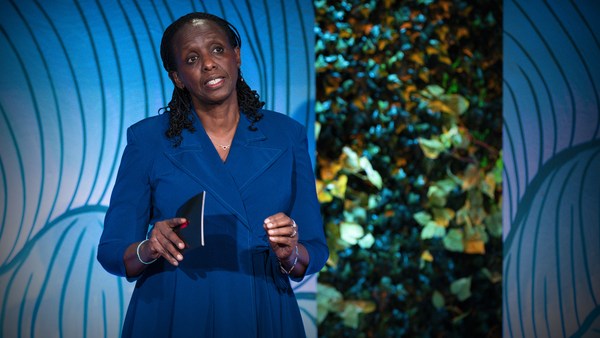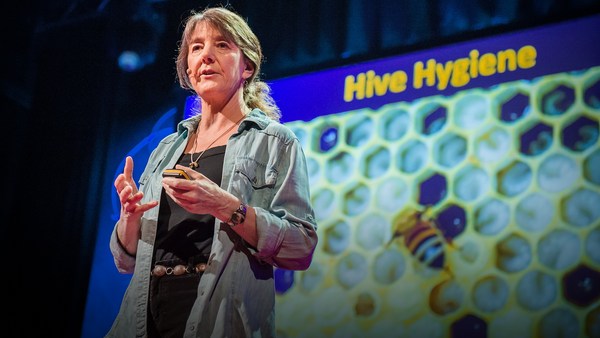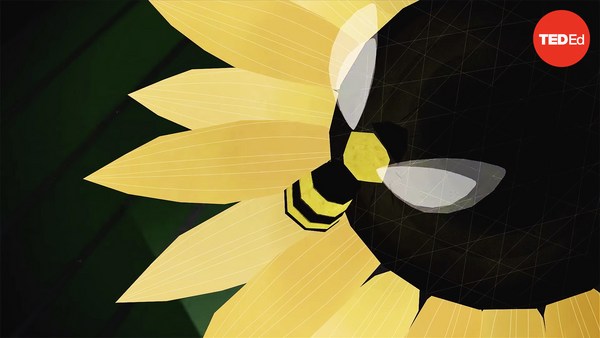So here's a strawberry. But not just any strawberry. This one can be up to three times sweeter than a regular one. Just like the ones I grew up eating in Japan.
As a child, when I came home and I saw strawberries on the table, it meant we were celebrating something special. Holidays, birthdays, anniversaries. Strawberries are considered the king of fruits in my culture, and they're never sold just as strawberries, they always have their varietal names. Amaou, Benni Hoppe, Tochiotome. Any Japanese person can name a few.
Up until now, these strawberries could only be grown under very specific Japanese climate conditions. But today you can grow them anywhere around the world using our vertical farming technology.
By the way, does anyone want to try these strawberries? Yeah? There you go. No fighting over them, we have more.
So today I'm going to try to give it a shot and try to convince everyone here that this technology is no longer some futuristic idea, but something that is going to mainstream very quickly, much, much sooner than you'd imagine, by sharing some of our secrets.
So how did I get here? I grew up in Japan, I came to the US in 2015 to pursue my MBA. On the second day of my arrival, I went to the local grocery store in California. I was amazed by the beautiful produce aisle. Green, red, yellow paprika side by side, everything was huge and shiny. The color was incredible. But the taste ...
(Laughter)
I was especially disappointed with strawberries. I thought I was eating a cucumber. I'm sorry.
I later learned that this is because the US agriculture system had optimized everything towards mass production, as opposed to quality and flavor. But this was the moment that I immediately realized that there's a huge opportunity here if I could grow Japanese-quality fruits and vegetables on US soil using vertical farming technology. But back then, experts told me that vertical farms were expensive and they could only grow leafy greens. So your lettuces, your kales, your spinaches, because anything beyond that requires bee pollination. But bees were known not to operate well in a sunless vertical farm environment.
But regardless, my partner Brendan and I, we decided to tackle this problem and started building our first farm in 2017, with our own hands. As two non-engineer MBAs, we nearly lost a few fingers just trying to cut PVC pipes. Almost electrocuted ourselves a few times. But we were really determined to solve one of the world's largest problems that mankind is facing this century: the failing agriculture system. Extreme weather, lack of water, lack of arable land, heavy use of pesticides, and just not enough workers to keep up with the growing population. All of these things have contributed in the global agriculture production cost. Vertical farms can actually solve all of these problems. We don't use any pesticides, we can recycle most of the water that we use, we don't even need arable land. In fact, one of our farms used to be a Budweiser factory. Imagine if you could turn all beer factories around the world into strawberry farms, we'd be much healthier, right? Yes? No? Some people think beer’s healthy. That's OK.
(Laughter)
But despite all of these benefits, skeptics still say, well, vertical farms are too costly of a solution. It's not a viable business model. I get it. They're not entirely wrong, right? We are still sort of expensive today, but think about where computers or mobile phones started, right? The real question is, can vertical farms get there and can we get there quickly enough?
What I can tell you is that a pack of our strawberries that you just ate, they used to go for 50 dollars per pack five years ago. Now they're 10 dollars, available in more than 100 grocery stores on the East Coast. So we came here in five years. So you can probably imagine at this pace where we could get to in another five years. We might even be cheaper than conventional products. But how? How is that even possible? Vertical farms look expensive, I hear you.
The short answer to that question is that we can innovate so much faster in a vertical farm, and we can also do things traditional farms simply can't do structurally. For example, in a traditional farm, you can only experiment once a year: during the season, under climate you have no control over.
At Oishii, we have dozens of grow rooms where we can control every aspect of the environment from things like temperature, humidity, CO2 levels, all the way down to even light spectrums and wind speed. So we can conduct experiments so much more efficiently in a controlled manner. And on top of that, we can start these experiments anytime during the year because we're not impacted by the outdoor seasonality at all.
And using this approach, we were able to go from just a few berries on a plant to five times of that in just a matter of five years. If you try to accomplish something like this in a traditional farm where you can only experiment once a year, it could have taken us nearly 500 years to get to the same outcome. And using this hyper-speed experiments, we were also able to accomplish three major breakthroughs: bee pollination, AI and robots.
Let's start with bees. I know this is everyone's favorite topic. You need bees to grow most produce, strawberries, tomatoes, melons, peppers, you name it, because the bees will pollinate the flowers that then become the product. But bees, they need the sun and the natural environment to navigate. So in a vertical farm, they wouldn't even come out of the hive. Even if they did, they will "drunk fly" and can't find the flowers. Just like how drunk humans are completely useless, so are drunk bees. They just can't get the job done. On top of that, you need somewhere between six to 15 visits by a bee to fully pollinate a strawberry flower. Anything less or more will result in missed pollination, meaning you won't have product. So for these reasons, an average Japanese farm a traditional farm is said to have a pollination success rate of somewhere between 60 to 70 percent, meaning three to four flowers don't even become products.
In order to solve all of these bee problems, Brendan and I, we interviewed many, many apiologists, experts. We spent so much time in the farm observing the bees ourselves, getting stung at times. Or ultimately we mapped out every environmental parameter of outdoor farms versus our indoor farms and went one by one. And after two years, finally figured out the bee recipe. So today we have bees, sober bees, in our farms, doing all the pollination for us. And what's more, with the help of data science and AI, our pollination success rate is above 95 percent, meaning more than nine flowers out of ten become berries.
(Applause)
So we're much more efficient than conventional methods. We have these self-driving camera carts that’s taking real=time visual data of every single plant in the farm, which helps us not only to determine yield and plant health information, but also how much bee activity is needed that day to help with the bee pollination. These AI-powered robots can automatically detect only the ripest berries, pick them automatically, and they can work 24/7.
So when data is coupled with AI and robots, you can do so many things you simply can't in a traditional farm setup. We even figured out how to extend our plants' lifespan. So our strawberry plants can keep them producing berries 365 days a year, as opposed to just a couple of months in a traditional farm. This means we're generating four to five times more revenue per plant per year. So here again, we're significantly more efficient.
So these are all of the reasons why, even though outdoor farming may seem cheaper, because we can innovate so much faster and because we can do things and achieve efficiencies, you possibly can't in a traditional farm, vertical farms can actually become cheaper than conventional farming, especially considering how conventional agriculture cost is only to go up from here.
And guess what? We are already doing this at a massive, massive scale. This building, which used to be a plastic factory, is now refurbished, it's solar powered, we're recycling majority of the water that we use. This farm is already producing strawberries every single day as we speak. And this technology can be used to grow so many more things beyond strawberries. Vertical farming is no longer some fluffy futuristic concept, but it's already here as we speak today, to change our lives and our planet for the better.
Imagine if these delicious, pesticide-free, sustainable strawberries were available at your local supermarket every single day, just for a few bucks. Isn't that a sweeter future?
Thank you.
(Applause)





